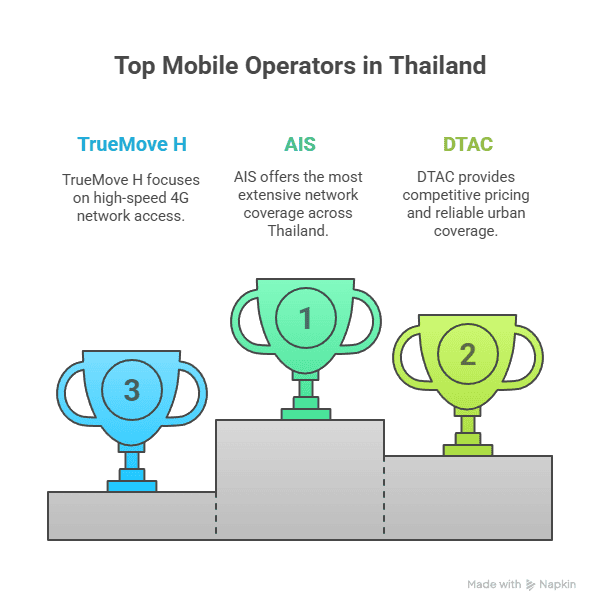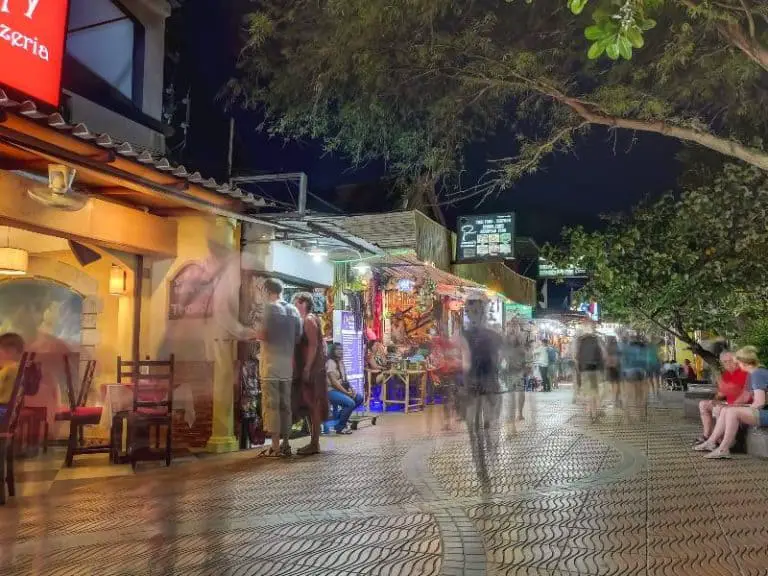Thailand SIM Card Foreigners: Complete Step-by-Step Guide
Landing in Thailand and needing to stay connected shouldn’t be stressful, especially when you don’t speak Thai. As someone who’s helped countless expats navigate Asia’s connectivity landscape, I’ve learned that getting a Thailand SIM card foreigners is essential if they want to access local mobile networks and use their phone for calls, texts, and internet browsing.
The good news? Foreigners can buy Thai SIM cards for their trip to Thailand with no restrictions, as long as they don’t own more than five per operator, and the entire process can be completed in English at most locations.
Key Takeaways
- Airport pickup is easiest – All major Thailand airports have English-speaking staff at AIS, DTAC, and TrueMove H kiosks for instant SIM card purchase and activation
- Passport required only – Foreign visitors need just their passport for SIM card registration; no Thai language skills or additional documents needed
- eSIM offers ultimate convenience – Buy online before travel, activate with a QR code, and get connected immediately upon landing without visiting any stores
Why You Need a Local Thailand SIM Card
Staying connected in Thailand goes beyond just posting vacation photos on social media. Having data on your phone makes life easier – you can open Google Maps for directions, order an Uber, find nearby restaurants, or contact friends without constantly asking for WiFi passwords.
By buying a local SIM card, you can take advantage of Thailand’s 4G/5G networks for better coverage, enjoy much cheaper rates than international roaming fees, and save money with data-only options if you don’t need calls or texts. The savings are substantial – while your home carrier might charge $10-15 per day for international roaming, local Thai SIM cards start at just $3-9 for week-long plans.
What’s The Best SIM To Use In Thailand?
Thailand has three major mobile operators that dominate the market, each offering comprehensive coverage and tourist-friendly services:

AIS (Advanced Info Service) – Generally considered to have the most comprehensive coverage, closely followed by TrueMove H and DTAC. AIS dominates with nine outright wins and three joint wins out of 15 awards, achieving a clean sweep in the 5G Experience section and retaining Download Speed Experience and Games Experience.
DTAC (Total Access Communication) – Known for competitive pricing and good urban coverage. DTAC is a good option for tourists due to its stable connection and coverage, offering varied data and validity options at reasonable prices.
TrueMove H – A subsidiary of True Corporation known for its high-speed 4G network with a strong focus on data services, popular among those who need fast and reliable internet access.
Network performance varies by location, but all three providers offer extensive coverage throughout Thailand, including major cities, tourist destinations, and many rural areas, with differences in data speeds being generally minor.
Where to Buy Thailand SIM Cards Without Speaking Thai
Airport Kiosks Are Your Safest Bet
Every international airport in Thailand has official DTAC, AIS, and TrueMove stores in the arrivals halls at baggage claim and often even before customs. Airport kiosks are specifically staffed with multilingual employees who can help tourists without any language barriers. Your SIM card works as soon as you leave the airport, and the kiosks are marked and impossible to miss.
Suvarnabhumi International Airport (BKK) has multiple kiosks throughout arrivals, while Don Mueang International Airport (DMK) has them on the Arrival Floor between Terminals 1 and 2. Phuket International Airport (HKT) houses them on the International Terminal 1st floor.
Official Carrier Stores in Shopping Malls
AIS, DTAC, and TrueMove H all have official stores and service centers throughout the country, particularly in major cities and tourist destinations. These stores offer the advantage of having the full range of packages available, often at better prices than airports. The staff at mall locations typically speaks basic English, especially in tourist areas.
Look for stores in major shopping malls like Siam Paragon and MBK Center in Bangkok, Central Festival in Phuket and Chiang Mai, or Terminal 21 locations nationwide. The mall environment provides a comfortable shopping experience with air conditioning and nearby restaurants if you need to wait.
Convenience Stores Require Extra Patience
In Thailand, you can buy a SIM card in every well-known convenience store: 7-Eleven sells DTAC and TrueMove, while Family Mart and Tesco also sell AIS. However, it’s not as convenient as it may seem since finding someone who can help you activate your prepaid data package can be challenging. The staff may speak limited English, and packages are often displayed only in Thai.
While convenience stores are everywhere and open 24/7, they lack technical support for activation issues. If you choose this route, come prepared with translation apps and patience, or consider it only as a backup option when other stores are closed.
The eSIM Revolution – Ultimate Convenience
Unmistakably, the best way to get internet on your phone when traveling to Thailand in 2025 is an eSIM. No need to swap physical SIM cards anymore or visit a SIM card store. You simply order an eSIM for Thailand on the internet and arrange everything within just a couple of minutes.
The eSIM process is remarkably simple:
- Order online before your trip from providers like Airalo, Holafly, or local carriers
- Receive a QR code via email instantly
- Scan and activate the following simple step-by-step instructions
- Connect automatically when your plane lands in Thailand
eSIM has the same function as a traditional tourist SIM card, but with instant installation and the ability to stay connected almost wherever and whenever you are. The only requirement is an unlocked and eSIM-compatible device.
Tourist SIM Card Plans and Pricing
Short-Term Plans for Weekend Getaways
Basic packages for 3-8 days typically cost 299-399 THB ($8-11 USD) and include 15-30 GB at high speed. These plans are perfect for weekend trips and short holidays where you need reliable data for maps, translation apps, and staying in touch with family. Most short-term packages also include some domestic calling minutes and basic SMS allowances.
Medium-Term Plans for Standard Vacations
Standard packages for 10-15 days range from 599-799 THB ($17-22 USD) and offer 30-50 GB at maximum speed. These plans include unlimited domestic calls and international call credits, making them ideal for two-week vacations. The additional features often include access to carrier WiFi hotspots and social media app packages.
Long-Term Plans for Extended Stays
Extended packages for 30 days cost 899-1,500 THB ($25-42 USD) and provide 50 GB to unlimited data. These plans are perfect for digital nomads and extended stays, often including premium support and free WiFi hotspot access. The unlimited options typically come with fair usage policies that throttle speeds after heavy usage.
Understanding What You’re Paying For
Most Thailand SIM cards for tourists have validity periods of 7, 15, or 30 days, with packages ranging from 299 THB to 899 THB depending on data allowances, calling minutes, and validity periods. Tourist packages are specifically designed with pre-configured settings that work immediately upon activation. Remember that prices can vary between different selling locations, with airports typically charging premium rates compared to city center stores.
Step-by-Step Buying Process (No Thai Required)
Finding the Right Counter at Airports
Follow the signs to “Mobile” or “SIM Card” areas in arrivals, which are typically located near baggage claim or just after customs. Compare kiosks since prices can vary between adjacent stands, even for identical packages. The displays are usually visual with English descriptions, making it easy to point to your preferred package without speaking Thai.
Required Documentation and Selection
Show your passport, as this is the only document required for SIM card registration in Thailand. Point to your preferred package on the visual displays, and let the English-speaking staff handle the technical aspects. Most tourist packages are clearly labeled with data amounts, validity periods, and prices in both Thai and English.
Installation and Testing Process
Let staff handle installation as they’ll insert the SIM card and test it before you leave the counter. Save important numbers like customer service and top-up codes that they’ll provide with your receipt. The staff will typically test calls and data connectivity to ensure everything works properly before completing your purchase.
Simple Communication Tips
While English is widely spoken at tourist-oriented locations, simple phrases like “SIM card for tourists” are universally understood. Staff will often show fingers to indicate duration when discussing package lengths. Visual displays and pointing work effectively for package selection, and most staff are experienced with helping international visitors.
Activation and Setup Process
Automatic Activation in Most Cases
In most cases, your purchased Thailand SIM card will automatically activate upon insertion into your phone. Simply power off your phone, insert the new SIM card, and power on while waiting for network registration. Test with a quick internet search or messaging app to confirm everything is working properly.
Manual Activation When Needed
If automatic activation doesn’t work, you can visit service centers where English-speaking staff can assist with troubleshooting. Call customer service using the numbers provided with your SIM package, as most carriers offer multilingual support. Most Thai operators also have English-language mobile apps that can help with account management and activation.
Setting Up Language Preferences
You can change SMS notifications to English by pressing *700, then following the voice prompts for language settings on most carriers. Download the carrier’s mobile app once your account is activated, as these apps allow you to manage your account, check data usage, and purchase additional packages. The apps typically have English interfaces and are much easier to navigate than USSD codes.
Testing Your Connection
Make a quick test call to ensure voice services work properly, then test data connectivity by opening a web browser or social media app. Check that you can send and receive SMS messages, and verify that your data speeds meet expectations for your chosen package. If you experience any issues, return to the point of purchase within 24 hours for assistance, as most vendors offer immediate technical support for new customers.
Managing Your SIM Card and Mobile Data
Checking your data balance is simple using USSD codes, which are shortcodes you can dial on your phone (e.g., *123#) to receive a text message with your remaining data. Most mobile carriers in Thailand also have their apps that you can download to easily check your data balance, manage your account, and purchase additional packages. These apps typically have English interfaces and are much more user-friendly than navigating phone menus.
Topping up your account is convenient since many stores in Thailand, such as 7-Eleven and FamilyMart, allow you to both buy and top up SIM cards at the counter. You can purchase top-up cards or vouchers with cash, or use the carrier apps to add credit directly with a credit card. The carrier apps are particularly useful for tourists since they eliminate language barriers and provide instant top-ups without visiting physical stores.
Common Challenges and Solutions

Language Barriers
One of the most frustrating experiences for foreigners is trying to communicate with staff at smaller stores who may not speak English fluently. This becomes particularly challenging when trying to understand different package options or troubleshooting activation issues. The best solution is to stick to airports and major mall locations where staff are specifically trained to help international customers. Alternatively, download translation apps like Google Translate beforehand, or take screenshots of package details you want to show staff.
Wrong Package Selection
You may often encounter misunderstandings about pricing and data plans, especially when staff assume you want the most expensive tourist package. Language barriers can make it difficult to compare options or understand what’s included in each plan. To avoid this, research packages online beforehand and screenshot your preferred option to show staff exactly what you want. Don’t be afraid to walk away and try another kiosk if you feel pressured or confused about the pricing.
Network Coverage Issues
Poor signal strength can be disappointing, especially in remote islands or mountainous areas where you need navigation the most. While all three major carriers offer good coverage in tourist areas, AIS is generally considered to have the most comprehensive network coverage nationwide. If you plan to visit remote locations or smaller islands, choose AIS for the best chance of staying connected. Consider purchasing a backup SIM from a different carrier if reliable coverage is critical for your travel plans.
Device Compatibility Problems
Nothing is more frustrating than buying a SIM card only to discover your phone won’t work with Thai networks. This usually happens because your phone is locked to your home carrier or doesn’t support the frequency bands used in Thailand. Before traveling, contact your home carrier to unlock your phone, or check online if your device model supports international networks. Most modern smartphones work perfectly with Thai networks once unlocked, but older devices may have compatibility issues.
Alternative Connectivity Options
International Roaming
While convenient, using international roaming with your home SIM card in Thailand can be quite expensive, and you might experience slower speeds compared to using a local SIM card or eSIM.
Pocket WiFi Rental
If you’re traveling with a group and need to connect multiple devices, renting a pocket WiFi device can be a good option, providing internet access for several devices simultaneously. However, keep in mind that pocket WiFi devices can be bulky and require charging.
Hotel and Public WiFi
Thailand has extensive free WiFi coverage in hotels, restaurants, and shopping centers. However, relying solely on WiFi limits your mobility and isn’t reliable for navigation or emergencies.
Tips for Heavy Data Users
If you’re a heavy data user, consider an unlimited data plan. Some providers in Thailand offer unlimited 4G/5G plans, although they might be more expensive than limited data plans.
For digital nomads and remote workers:
- Choose unlimited plans for peace of mind
- Test speeds first before committing to long-term packages
- Consider multiple SIMs from different carriers for backup coverage
- Monitor fair usage policies – unlimited often means unlimited at full speed up to a certain threshold
Understanding Data Allowances
Oftentimes, 15GB to 30GB of data will be enough to cover 10 days for those with regular data usage. If you want to use more data or travel for a longer duration (more than 1 month), you may want to get a plan with higher data volume or longer validity.
Data usage guidelines:
- Light users (messaging, maps): 1-2 GB per week
- Moderate users (social media, browsing): 5-10 GB per week
- Heavy users (streaming, video calls): 15-30 GB per week
- Power users (remote work, content creation): Consider unlimited plans
5G vs 4G Coverage
Thailand’s 5G rollout has been impressive, with TrueMove H winning 5G Availability outright for the second time in a row, with a score of 27.9%, while DTAC sees the highest boost, bringing its score to 26%, and AIS placing third with 24.9%.
However, 5G networks are focused on major Thai cities like Bangkok, Chiang Mai, and Phuket. In cities, 4G coverage approaches 100% indoor and outdoor, but rural/mountainous regions still experience occasional 3G-only zones.
For most tourists, 4G coverage is more than sufficient, but if you’re staying in major cities and have a 5G-capable device, the enhanced speeds can be beneficial for video streaming and large file uploads.
Frequently Asked Questions
Can I buy a Thailand SIM card online before traveling?
Yes, you can buy a Thailand tourist eSIM online with instant installation, which has the same function as a traditional tourist SIM card. Many international providers offer Thai eSIMs that you can purchase and activate before departure.
Do I need to speak Thai to buy and use a SIM card?
No, buying a SIM card at Bangkok Airport is more recommended than buying it in the city because airports have English-speaking staff. Major tourist areas and carrier stores also have English-speaking staff.
How much does a tourist SIM card cost in Thailand?
You can get a daily Thailand SIM card for as little as £1, while plans that last a week cost a couple of pounds more. 15-day SIM cards start at £7 and go up to £15 for deals with unlimited data and calls.
Which network has the best coverage for tourists?
While coverage can vary slightly depending on location, AIS is generally considered to have the most comprehensive coverage, closely followed by TrueMove H and DTAC. For most tourist destinations, all three networks provide reliable service.
Can I use my existing phone with a Thai SIM card?
Yes, but before buying a Thailand SIM card, make sure that your phone is carrier-unlocked so it can receive signals from cellular operators in Thailand. Most modern smartphones work perfectly with Thai networks once unlocked.
Conclusion
Getting connected in Thailand as a foreigner has never been easier, even without speaking a word of Thai. Whether you choose the convenience of an eSIM purchased from home, grab a tourist package at the airport, or visit an official carrier store, staying connected during your Thai adventure is straightforward and affordable.
The key is choosing the right option for your travel style and data needs. Airport kiosks offer the most hassle-free experience with English-speaking staff, while eSIMs provide ultimate convenience for tech-savvy travelers. With this guide in hand, you’ll be posting those temple selfies and navigating Bangkok’s streets like a connected pro in no time.
Ready to explore Thailand without connectivity worries? Choose your preferred method from this guide or let us help you, and step off that plane already connected to the Land of Smiles.






